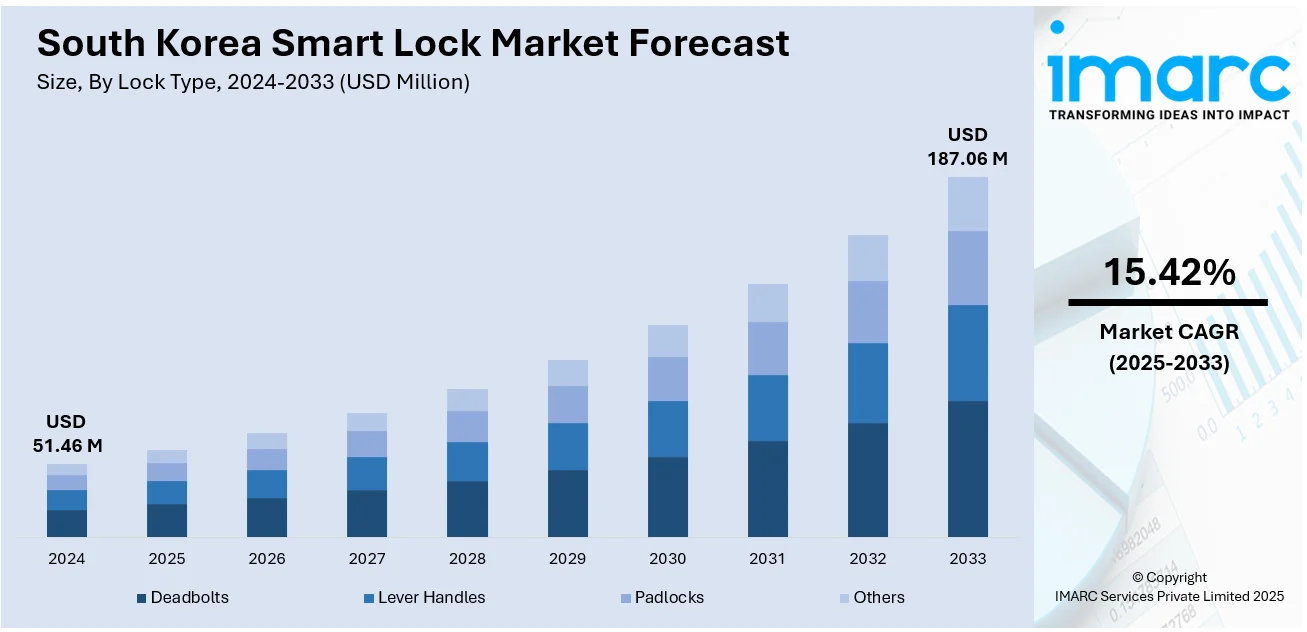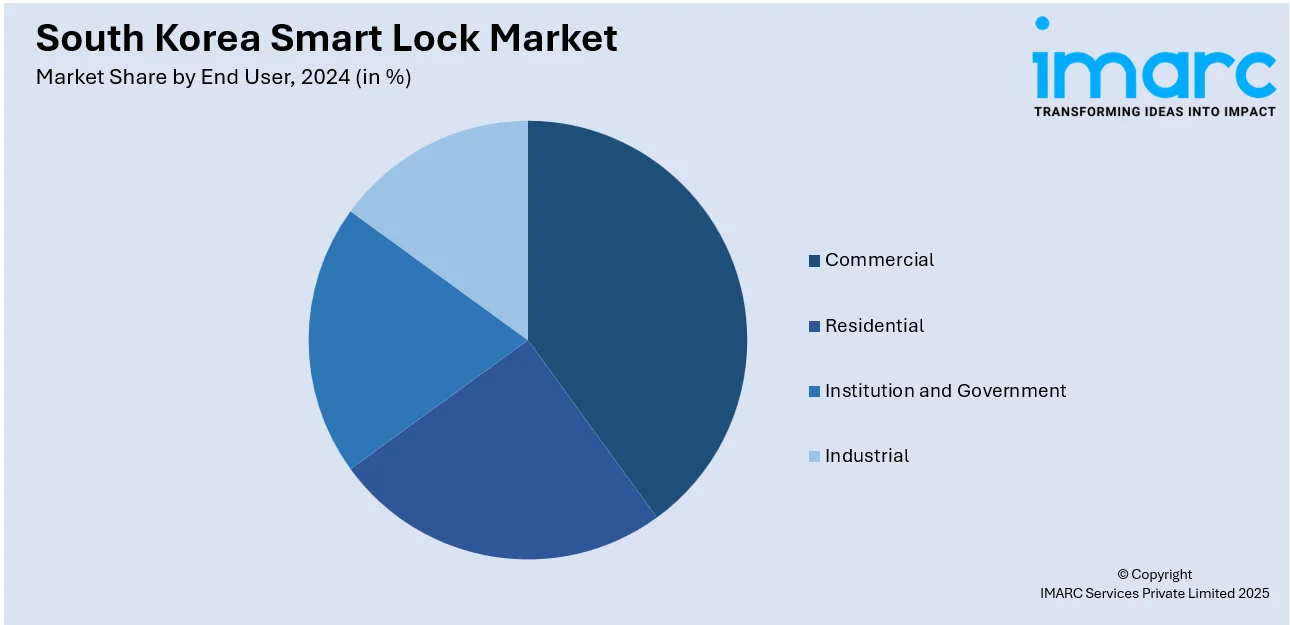
South Korea Smart Lock Market Size, Share, Trends and Forecast by Lock Type, Communication Protocol, End User, and Region, 2025-2033
South Korea Smart Lock Market Overview:
The South Korea smart lock market size reached USD 51.46 Million in 2024. The market is projected to reach USD 187.06 Million by 2033, exhibiting a growth rate (CAGR) of 15.42% during 2025-2033. People are seeking better protection from theft, and smart locks are offering features like fingerprint access, remote control, and activity alerts. Besides this, as homes are becoming more connected through the Internet of Things (IoT), people prefer locks that integrate with smartphones and smart home systems, which is fueling the South Korea smart lock market share.
|
Report Attribute
|
Key Statistics
|
|---|---|
|
Base Year
|
2024
|
|
Forecast Years
|
2025-2033
|
|
Historical Years
|
2019-2024
|
| Market Size in 2024 | USD 51.46 Million |
| Market Forecast in 2033 | USD 187.06 Million |
| Market Growth Rate 2025-2033 | 15.42% |
South Korea Smart Lock Market Trends:
Growing security concerns
Rising security concerns are fueling the market growth in South Korea. As more people are living in urban areas and high-rise apartments, they are becoming more aware about the risks of break-ins and theft. In 2024, the World Bank reported South Korea's urban population at 42,176,083. Traditional locks no longer feel safe enough, especially with reports of lock-picking and key duplication. People want better ways to protect their homes and families. Smart locks offer stronger security features like fingerprint scanning, password entry, and remote access through smartphones. These features make it harder for intruders to break in. Smart locks also keep records of who enters and leaves the house, giving homeowners peace of mind. Some models even send alerts if someone tries to tamper with the lock. Parents feel safer knowing their children can get in without losing keys. Elderly people also benefit from easy-to-use, keyless options. As more cases of burglary and property crime are appearing in the news, the demand for smarter and more reliable locks is increasing. Businesses and landlords are also investing in smart locks to keep their properties secure. Overall, the desire for better safety at home and work is motivating more people to choose smart locks in South Korea.

To get more information on this market, Request Sample
Increasing use of IoT
Rising adoption of the IoT is impelling the South Korea smart lock market growth. As more devices in homes are becoming connected, people want locks that can easily integrate with their smart home systems. Smart locks that work with smartphones, voice assistants, security cameras, and home automation platforms are in high demand. People who are tech-savvy and used to fast internet and digital services are quick to adopt these solutions. IoT-enabled smart locks allow individuals to control and monitor access to their homes from anywhere, using apps or connected devices. This adds convenience, especially for families and working professionals. The ability to grant or revoke access remotely is also helpful for deliveries, guests, or service workers. Businesses are employing IoT-based smart locks to manage employee access and monitor entry logs in real time. With South Korea’s strong digital infrastructure and the growing smart home ecosystem, IoT adoption continues to rise. This is driving steady demand for smart locks that are not only secure but also fully connected. As smart homes are being developed, smart locks are becoming an essential part of the overall IoT experience. According to industry reports, the South Korea smart home market is set to attain USD 23.31 Billion by 2030.
South Korea Smart Lock Market Segmentation:
IMARC Group provides an analysis of the key trends in each segment of the market, along with forecasts at the country and regional levels for 2025-2033. Our report has categorized the market based on lock type, communication protocol, and end user.
Lock Type Insights:
- Deadbolts
- Lever Handles
- Padlocks
- Others
The report has provided a detailed breakup and analysis of the market based on the lock type. This includes deadbolts, lever handles, padlocks, and others.
Communication Protocol Insights:
- Bluetooth
- Wi-Fi
- Others
A detailed breakup and analysis of the market based on the communication protocol have also been provided in the report. This includes Bluetooth, Wi-Fi, and others.
End User Insights:

- Commercial
- Residential
- Institution and Government
- Industrial
The report has provided a detailed breakup and analysis of the market based on the end user. This includes commercial, residential, institution and government, and industrial.
Regional Insights:
- Seoul Capital Area
- Yeongnam (Southeastern Region)
- Honam (Southwestern Region)
- Hoseo (Central Region)
- Others
The report has also provided a comprehensive analysis of all the major regional markets, which include Seoul Capital Area, Yeongnam (Southeastern Region), Honam (Southwestern Region), Hoseo (Central Region), and others.
Competitive Landscape:
The market research report has also provided a comprehensive analysis of the competitive landscape. Competitive analysis such as market structure, key player positioning, top winning strategies, competitive dashboard, and company evaluation quadrant has been covered in the report. Also, detailed profiles of all major companies have been provided.
South Korea Smart Lock Market News:
- In January 2025, Jikbang released a new smart home door lock, ‘Haven (ZD-R90)’, featuring artificial intelligence (AI) in South Korea. It was defined by the implementation of the ‘passwordless’ method, which removed numeric keypads from digital door locks for the first time in South Korea, inculcating a minimalist design with curved oval handles.
South Korea Smart Lock Market Report Coverage:
| Report Features | Details |
|---|---|
| Base Year of the Analysis | 2024 |
| Historical Period | 2019-2024 |
| Forecast Period | 2025-2033 |
| Units | Million USD |
| Scope of the Report |
Exploration of Historical Trends and Market Outlook, Industry Catalysts and Challenges, Segment-Wise Historical and Future Market Assessment:
|
| Lock Types Covered | Deadbolts, Lever Handles, Padlocks, Others |
| Communication Protocols Covered | Bluetooth, Wi-Fi, Others |
| End Users Covered | Commercial, Residential, Institution and Government, Industrial |
| Regions Covered | Seoul Capital Area, Yeongnam (Southeastern Region), Honam (Southwestern Region), Hoseo (Central Region), Others |
| Customization Scope | 10% Free Customization |
| Post-Sale Analyst Support | 10-12 Weeks |
| Delivery Format | PDF and Excel through Email (We can also provide the editable version of the report in PPT/Word format on special request) |
Key Questions Answered in This Report:
- How has the South Korea smart lock market performed so far and how will it perform in the coming years?
- What is the breakup of the South Korea smart lock market on the basis of lock type?
- What is the breakup of the South Korea smart lock market on the basis of communication protocol?
- What is the breakup of the South Korea smart lock market on the basis of end user?
- What is the breakup of the South Korea smart lock market on the basis of region?
- What are the various stages in the value chain of the South Korea smart lock market?
- What are the key driving factors and challenges in the South Korea smart lock market?
- What is the structure of the South Korea smart lock market and who are the key players?
- What is the degree of competition in the South Korea smart lock market?
Key Benefits for Stakeholders:
- IMARC’s industry report offers a comprehensive quantitative analysis of various market segments, historical and current market trends, market forecasts, and dynamics of the South Korea smart lock market from 2019-2033.
- The research report provides the latest information on the market drivers, challenges, and opportunities in the South Korea smart lock market.
- Porter's five forces analysis assist stakeholders in assessing the impact of new entrants, competitive rivalry, supplier power, buyer power, and the threat of substitution. It helps stakeholders to analyze the level of competition within the South Korea smart lock industry and its attractiveness.
- Competitive landscape allows stakeholders to understand their competitive environment and provides an insight into the current positions of key players in the market.
Need more help?
- Speak to our experienced analysts for insights on the current market scenarios.
- Include additional segments and countries to customize the report as per your requirement.
- Gain an unparalleled competitive advantage in your domain by understanding how to utilize the report and positively impacting your operations and revenue.
- For further assistance, please connect with our analysts.
 Request Customization
Request Customization
 Speak to an Analyst
Speak to an Analyst
 Request Brochure
Request Brochure
 Inquire Before Buying
Inquire Before Buying




.webp)




.webp)












